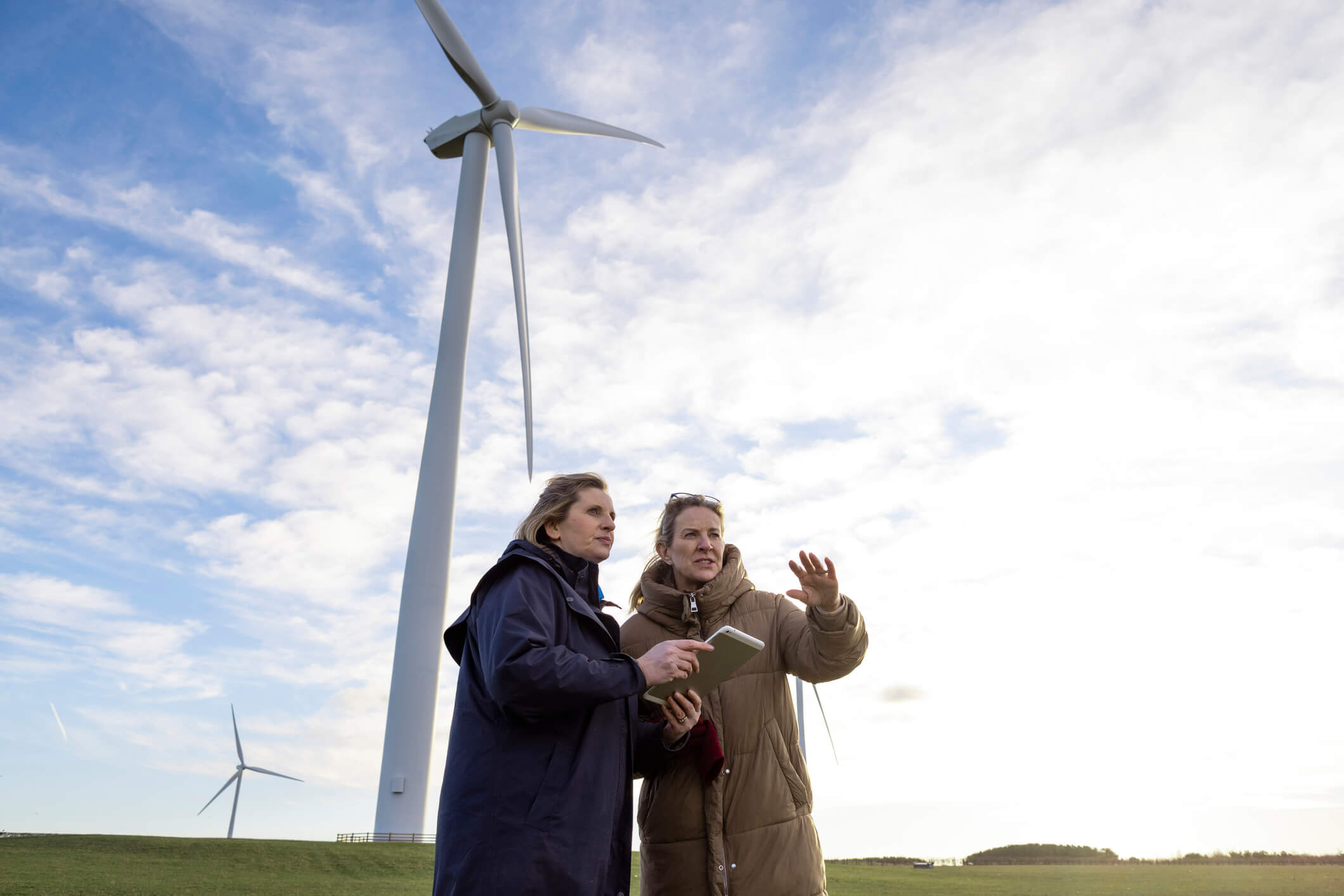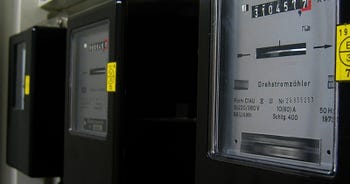What is wind energy and how efficient is it for my business?
Each year we, as a nation, edge closer towards our net zero target set for 2050. As every business owner will know, there are many challenges when it comes to running a business, so it's understandable if upgrading to a renewable energy system isn't top of your mind.
But if you are interested, wind power is one way to go about it — especially if you’re looking for a renewable energy option that won’t break the bank and works in windy areas.
Wind power is a tried and trusted method that businesses and homes alike have been using for hundreds of years in one way or another. Did you know in 2022, wind power contributed 26.8% of the UK’s total electricity generation?
Learn more about these towering giants and how they really work in this Bionic guide.

30-second summary
- The natural wind that gusts across our shores can be used to harness energy to power up businesses across the UK. Wind power is one of the oldest sources of renewable energy and is a low-carbon, sustainable option.
- Wind energy is generated when the wind turns the rotor blades on a turbine, creating kinetic energy. This energy is then ready for small businesses to use as electricity instead of buying from the grid.
- Wind energy has many benefits including no air pollutants or greenhouse gas emissions, and it's a long-term investment that could lower energy bills over the long run. It also reduces reliance on fossil fuels and imported energy sources from abroad, giving the UK energy independence.
- Drawbacks include conflicts in land use, complaints about aesthetics and reliance on unstable British weather. But, generally, the benefits of this efficient energy source outweigh the negatives.
What is wind energy?
Wind power is a type of energy caused by the sun's uneven heating of the atmosphere, the differences in the earth's surface and its rotation. This combination leads to the generation of wind, which powers the turbines.
Wind energy is one of the oldest energy sources used by humans and, today, is one of the most established and efficient renewable energy sources that we can use.
How does wind energy work?
Wind power works by using wind turbines that are fitted with large blades that rotate. When there is sufficient wind to turn the blades, kinetic energy is produced and converted into electrical energy.
Typically, a generator is used during the process to convert the mechanical power from the turbine into electricity, which then powers homes and businesses across the UK.
What is a wind turbine?
A renewable wind turbine is the modern equivalent of a windmill, with the first of its kind being created in 1887, by Professor James Blyth, a Scottish engineer. Unlike early windmills, the turbines we know today use generators and other components to convert energy from the spinning blades into a flow of electricity.
There are usually three main parts of a wind turbine that work together to create electricity:
- The rotor — Composed of three blades, its function is to capture the force of the wind and convert it into mechanical rotational energy.
- The multiplier — Connected to the engine, it aims to increase the rotational speed of the blades in order to generate more electricity.
- The generator — This part of the turbine is responsible for converting the mechanical energy of rotating blades into electrical energy.
What are the different types of wind energy?
Both onshore and offshore wind energy harness the power of the air to generate electricity, but their location and some of their technical aspects differ slightly.
Onshore wind energy
Located mostly on land in areas like plains, hilltops, and coastlines, onshore wind turbines are typically easier and more cost-effective to install than offshore turbines.
Their towers generally range between 50 to 100 meters, and being land-based offers quicker construction due to simpler logistics and more mature technology. But this doesn’t mean they don’t present some challenges. Land-use conflicts with industries such as agriculture or housing, threats to bird and bat populations, and sometimes resistance from local communities over noise and aesthetics can all cause conflicts.
Wind consistency on land doesn’t always match that of offshore locations because of built-up areas and calmer winds than at sea, so they don’t generate the same amount.
Offshore wind energy
Positioned at sea or on large lakes, offshore wind turbines are engineered to withstand conditions at sea like saltwater corrosion, galeforce winds, and tidal waves. The turbines often stand taller than 150 meters, allowing them to capture more energy.
Offshore wind offers more consistent wind generation with robust conditions and fewer concerns over its visual impact and loud noise.
But, it doesn’t come without some challenges, like higher installation and maintenance costs, potential environmental impacts on marine ecosystems, and technical issues related to operations and power transmission to the shore — it’s not as easy to go out and fix a turbine at sea!
What are the advantages of wind energy?
Despite the drawbacks, wind energy offers many advantages, contributing to its growing popularity as a renewable energy source.
- Environmental benefits — Wind power is a clean and renewable energy source that produces no air pollutants or greenhouse gas emissions during operation. It significantly reduces our carbon footprint and helps combat climate change by reducing the need for fossil fuels like coal, oil, and natural gas, which release harmful pollutants when burned.
- Energy independence — Wind energy reduces dependence on finite and imported fossil fuels, enhancing energy security and reducing vulnerability to geopolitical tensions and price fluctuations associated with oil and gas markets. This helps countries achieve greater energy independence and stability.
- Cost savings — Once a wind turbine is installed, the ongoing operational costs are relatively low, mainly involving maintenance and occasional repairs. While the initial investment and installation costs can be high, better technology and increased use have led to a drop in the cost of wind energy over the past few years, making it more competitive with traditional fossil fuels.
- Long-term investment — Wind energy projects typically have long lifespans, ranging from 20 to 30 years or more. This provides a stable and predictable source of electricity production over the long term, contributing to energy security and stability in the energy market.
- Community engagement — Wind energy projects often involve local communities through various stages, including planning, development, and operation. This encourages positive relationships between project developers and communities, bringing them together, and leading to extra support for renewable energy initiatives. Wind farms also provide job opportunities for local communities and lease payments to landowners.
What are the disadvantages of wind energy?
While wind energy has many benefits, it also comes with disadvantages that need to be considered when evaluating its feasibility.
- High initial costs — Installing wind turbines and associated infrastructure can involve high upfront capital costs. While the cost of wind energy has decreased over the years, the initial investment can still be a barrier, especially for smaller-scale businesses or regions with limited financial resources. Smaller turbines generating around 2,000 kWh per year can cost between £2,000-£6,000 while installing a larger unit can see prices upwards of £20,000. Larger models do generate more power — around 9,000 kWh per year, which is the equivalent of powering a factory for a year.
- Location dependency — Wind energy generation is highly dependent on the weather and works best on days with high wind speeds. Not all areas of the country have suitable wind resources for efficient and cost-effective energy production — they won’t work for businesses in city centres, for example. This means wind power isn’t a renewable option for those types of businesses.
- Maintenance and repairs — Wind turbines are complex systems and require regular maintenance and occasional repairs to ensure they’re performing at their very best. Maintenance tasks often involve working at heights, which can be challenging for workers and costly for businesses.
- Noise and visual impact — Wind turbines can generate noise, especially near residential areas. While technology is improving to produce units with lower noise, there are still concerns about the potential impact on human health and quality of life, some people find wind turbines in landscapes to be an eyesore and intrusive.
- Grid integration — The nature of wind energy production poses challenges for grid integration. Sudden changes in wind speed can lead to fluctuations in electricity output, putting pressure on the grid system. The more small turbines integrated into the grid, the more management and coordination are needed, with other energy sources, in order to maintain a stable and reliable grid.
What is a wind farm?
Wind farms are a group of wind turbines placed in a specific area to harness the wind's kinetic energy.
Essentially, wind farms are designed to generate electricity on a larger scale than individual wind turbines.
They’ll also be located in the windiest places possible to maximise the energy they can create. That’s why we tend to see them on offshore farms at sea or in fields in rural areas where tall buildings and other obstacles won’t interrupt their airflow.
How strong does the wind need to be for a wind turbine to work?
Wind turbines will generally operate between 7 mph and 56 mph, with their maximum output reached at around 27 mph.
A typical turbine requires wind speeds of about 10 mph to start generating power.
How efficient is wind power?
A wind turbine's efficiency can vary based on a range of factors such as its design, location and the average wind speed in that area.
Essentially, modern wind turbines can achieve conversion efficiencies of around 30-45%, increasing to around 50% during peak wind times. This is considered good - if a wind turbine were to work at 100% efficiency, the wind would completely drop after going through the blades!
Find your next renewable energy option with Bionic
Wind power can be a great investment for businesses searching for greener options. While the initial upfront price can be costly, you’ll be able to reap the benefits after the payback period.
If you need more help understanding business energy, head over to our energy guide pages for more information. Or, get in touch today with the Bionic team to compare your business energy needs, including electricity and gas.








